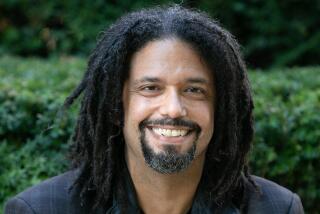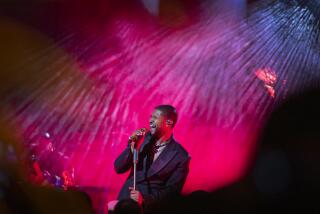A Sentimental Journey to the Hollywood Palladium’s Past
- Share via
It was Oct. 31, 1940--Halloween.
And what better place to throw a giant party during that golden era of big-band music than the luxurious Hollywood Palladium?
Fittingly, it was opening night.
Outside, blinding searchlights scanned clear skies as throngs of fans gathered early for a glimpse of arriving film stars and celebrities who traditionally attended such flashy events.
Inside, an overflow crowd estimated at more than 10,000 jammed the dance floor as actress Dorothy Lamour walked on stage to greet bandleader Tommy Dorsey.
The Ribbon Is Cut
After a few words, she cut a ribbon of orchids, officially opening the spacious dance hall.
And soon Dorsey began sliding his trombone effortlessly through the opening strains of his still-popular theme song, “I’m Getting Sentimental Over You.”
Adding their vocal talents to Dorsey’s music were the Pied Pipers, headed by Jo Stafford, and a skinny young New Jersey singer, Frank Sinatra.
That historic scene of 46 years ago will be recalled Thursday night, when the KCET Women’s Council stages “A Coast to Coast Evening: Getting Sentimental With Tommy Dorsey,” at the now world-famous ballroom.
Veteran trombonist Buddy Morrow, known as Moe Zudekoff when he was with Tommy Dorsey’s brother in the original Jimmy Dorsey orchestra, will lead his own group, emulating the rich, mellow sounds of Tommy’s band.
Singer Mel Torme will headline as host and master of ceremonies and will be backed by vocalists Jack Jones, Maureen McGovern and the L.A. Voices, a five-member CBS recording group. Drummer Buddy Rich also will be featured.
Cocktails will be served at 6:15 p.m., followed by a gourmet dinner by Rococo and “touch” dancing to such memorable hits as “Star Dust,” “Night and Day,” “Chicago,” “I’ll Be Seeing You,” “Song of India,” “Marie” and many other classics Dorsey and his band helped make famous.
Even floral decorations will have a familiar look, if not fragrance. Jerry Stathatos, who owns the Broadway Florist shop and who decorated the Palladium on opening night, is responsible for entryway floral arrangements.
Sold out long ago, the $200-a-ticket, black-tie KCET benefit will be taped for a 90-minute national telecast on PBS stations this summer. Produced by Jim Washburn, the show is titled “Sentimental Swing: The Music of Tommy Dorsey.” Because tables will occupy floor space, only 1,100 are expected, considerably fewer than on opening night.
No doubt, the event will stir many memories, and possibly soundly jar a few as well.
Dorothy Lamour, for example, couldn’t immediately recall having attended the opening almost half a century ago--until she cast her eyes on a copy of the newspaper clipping that showed her standing next to Dorsey, scissors in hand.
Contacted the other day at her home in North Hollywood, Lamour remembered that “it was a very elegant night, a fun night.
“It must have been a very special occasion,” she continued, “because I didn’t stay out very late in those days when I had to get up so early to be at the studio. I don’t even recall who my date was--maybe Bob Preston or Greg Bautzer, an attorney in town.”
Preston wasn’t available to clarify the point, but Bautzer later remarked, “I think it must have been the other gentleman. I’m sorry. I wish I had been lucky enough to have taken her.”
“I loved the big-band era,” Lamour continued, “and I think it’s coming back. It already has a lot. I just did a couple of benefits in New England with Jimmy Dorsey’s orchestra.”
Another Hazy Memory
Lana Turner’s memory also was hazy.
In Bruce Torrance’s book, “Hollywood: The First Hundred Years,” published in 1979, the “luscious Lana Turner” is mentioned as having “starred in the ground-breaking ceremony” of the Palladium “exactly four months” before opening night. She reportedly used a “silver shovel” to turn the earth on Sunset Boulevard, in the block between Argyle Avenue and El Centro Street.
“I swear to you,” she said over the telephone a few days ago, “I do not recall a golden spade or silver spade or anything about a ground-breaking ceremony. They made up all kinds of things about (show-biz) people then, but things that were not harmful.”
Actually, Turner was present at the ground-breaking ceremony on June 10, 1940, but the “star” apparently was comedian Ken Murray, with an assist from “Miss Hollywood,” Beverly Bush.
Turner and her husband at the time, bandleader Artie Shaw, were interviewed on CBS radio during the festivities, according to a story published in The Times.
“I do remember that was the most wonderful place to go,” Turner continued. “I would go to the Palladium four or five times a week. It was the place to go after dinner or after a movie. We young ladies could walk in alone and know we weren’t going to . . . you know, be picked up.
“It was a marvelous, marvelous place during its glory years.”
Turner, recovering from recent dental surgery, plans to attend Thursday’s show as the guest of producer Howard Koch and his wife.
Jo Stafford’s memories of playing the Palladium opening night also are vague, but she clearly remembers the dressing rooms.
Speaking from her Century City home, where she lives with her husband, Paul Weston (an arranger for Dorsey in his heyday), Stafford was “pretty impressed” with the accommodations backstage.
“We just played one-night stands,” she said. “We were used to little ratty places on the road.”
Certainly, there was nothing “ratty” about the Palladium of the ‘40s. Reportedly built for $250,000, the Palladium--built on the site of the original Paramount Studio--was the dream of former film producer Maurice M. Cohen, president of Southern California Enterprises Inc.
Under a sky-blue ceiling of tiny stars, a “floating” dance floor of curved planks was laid on a base of cork to facilitate a slight spring.
The ballroom-restaurant included six bars--four serving liquor and two providing soft drinks for the younger set. For years, it was the place to celebrate high-school prom night.
“They were all young people,” said Earl Vollmer, who was the Palladium’s general manager at the time. “Old people didn’t come there. They went to see Lawrence Welk at the beach.”
Still Active at 91
Vollmer, at 91 still active as assistant general manager of the El Caballero Country Club in Tarzana, said he was brought out from Cincinnati to open the Palladium.
Most of the top big bands of the period played there, but Tommy Dorsey--credited with changing the trombone sound from brassy and raucous-Dixie to a mood-setting melodic sound--was first.
Singer Jack Leonard, who, in 1937, introduced “Marie” (a song he still is closely identified with) and “Once in a While” when he was featured with the band, called Dorsey a “very complex man.”
“He was very difficult to work for, but not for me. He knew what he wanted. . . . He was disliked by many because he was bombastic and unreasonable.”
A vocalist with Dorsey for four years, Leonard left to serve in the Army and was replaced by Sinatra. To this day, critics occasionally speculate about who would have been No. 1 had Leonard not been gone five years, while Sinatra’s fame was skyrocketing.
Leonard laughed. “I’d be very grateful,” he said, “to be No. 2.”
Some of the musicians who worked for Tommy Dorsey--saxophonists Skeets Herfurt, Heinie Beau and Ernani Bernardi (yes, the Los Angeles city councilman)--described their boss similarly in recent telephone interviews.
“He was very ambitious,” Herfurt remembered, “and one of the greatest trombone players who ever lived. I learned an awful lot from Tommy. If you were loyal to Tommy, he would be very loyal to you.”
Herfurt remembered the Palladium opener more clearly than most. “The crowd went crazy,” he said. “They stood in front of the bandstand 15 or 20 deep. They just stood and watched us.”
Beau also was on the stage that night. “It was very exciting,” he recalled, “a fantastic evening. Bob Hope and a lot of movie people were there.”
Movie-Making Band
While performing at the Palladium, “seven days a week plus matinees on Saturdays and Sundays,” the band also was making a movie, “Las Vegas Nights,” at Paramount.
Dorsey often cut his time a bit thin when leaving the studio for the ballroom, Beau recalled. “He would pick up his horn cold, rush on stage without warming up and start his theme.”
Bernardi, who joined Tommy Dorsey in 1934 and left early in 1936 to play sax for Kay Kyser, remembered Tommy’s collection of toy trains. “He was quite a bug on those,” the councilman said. “I don’t know if he ever got time to run them, but he sure had a room full. It was the only hobby he ever had, except his trombone.”
The band once formed a softball team, Bernardi recalled, and Dorsey became upset when the weary musicians apparently didn’t perform up to par one evening.
“ ‘You’re paid to be musicians, not athletes,’ Tommy said. . . . He was a hard, hard worker.
“Modern trombone players of today owe him a debt of gratitude,” Bernardi continued. “Until he came along, the trombone was considered a background instrument, low notes basically. He was the first to really bring the trombone to the forefront.”
Clearly, for many of those present Thursday night, the evening will, indeed, be a “sentimental” experience.
More to Read
The biggest entertainment stories
Get our big stories about Hollywood, film, television, music, arts, culture and more right in your inbox as soon as they publish.
You may occasionally receive promotional content from the Los Angeles Times.










